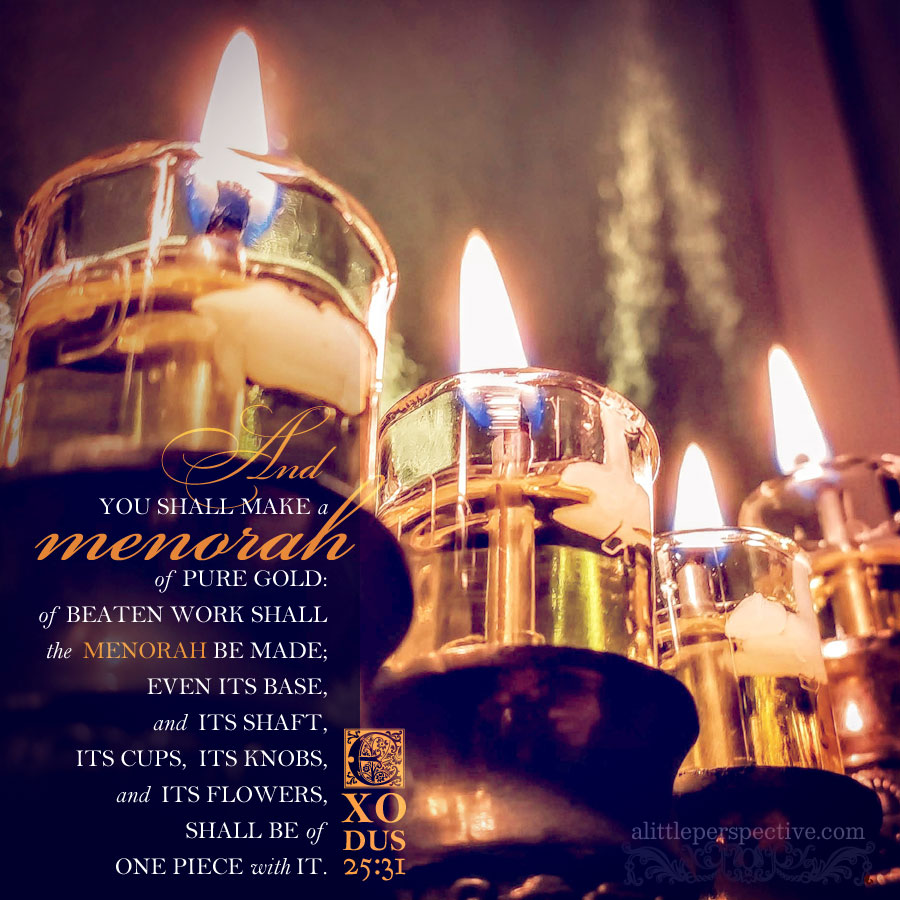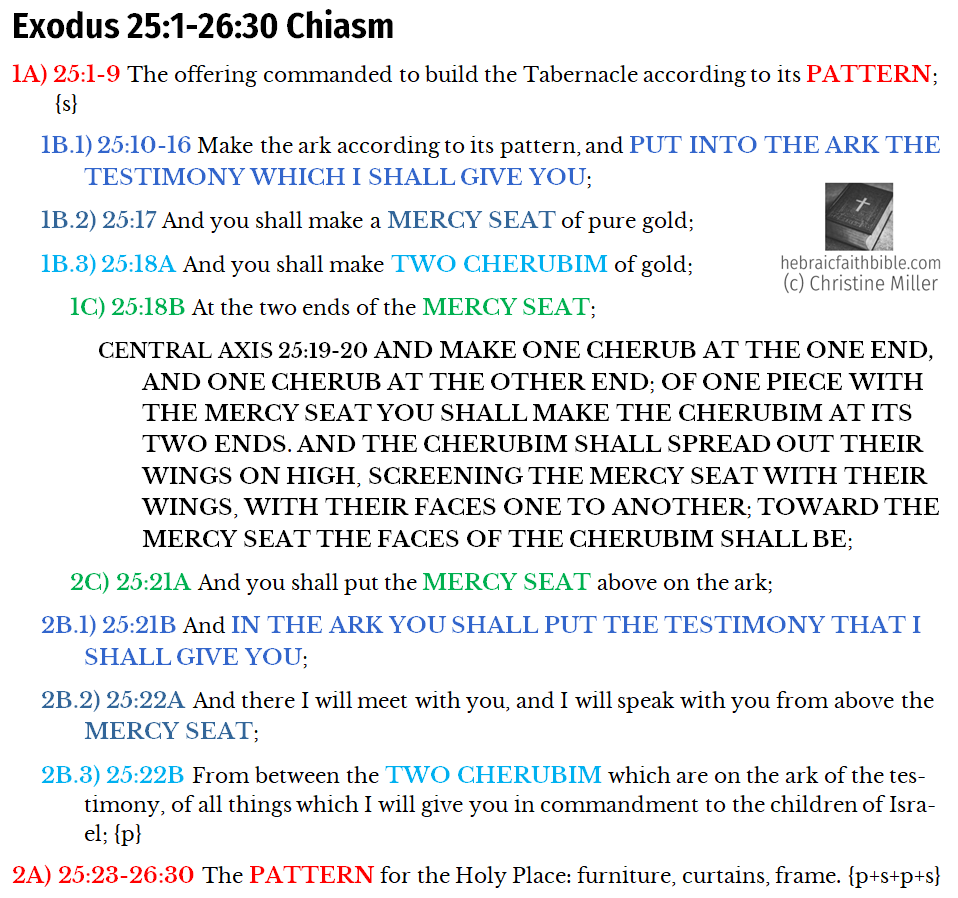Read Exodus 25:1-26:30 at Bible Gateway.
The teaching tools of scripture
Gen 1:1-2:3 and the teaching tools of scripture part one and part two
Gen 1:1-6:8 and finding the topic themes of scripture
Hebrew paragraph divisions
25:1-9 {s} The offering commanded to build the Tabernacle
25:10-22 {p} The pattern for the ark of the covenant
25:23-30 {p} The pattern for the table of showbread
25:31-40 {s} The pattern for the golden lampstand
26:1-14 {p} The pattern for the curtains and coverings of the Tabernacle
26:15-30 {s} The pattern for the frame of the Tabernacle
Strong themes of the parashah
25:1-22 {s+p} YHVH’s sacred place is the Most Holy Place
25:23-26:14 {p+s+p} The pattern for furnishings and coverings for the Holy Place
Exo 25:1-26:30 Chiastic structure
Download the fully expanded Exo 25:1-26:30 Triennial Terumah chiasm pdf (Coming …).
Theme of the parashah
The offering commanded and the pattern given for the Tabernacle, that YHVH may dwell among them.
Finding Messiah in Triennial Terumah
And there came unto me one of the seven angels who had the seven bowls full of the seven last plagues, and talked with me, saying, “Come here, I will show you the bride, the Lamb’s wife.” And he carried me away in the Spirit to a great and high mountain, and showed me that great city, the holy Jeru-salem, descending out of heaven from God … And I saw no temple in it, for the Lord God Almighty and the Lamb are its temple. And the city had no need of the sun, neither of the moon, to shine in it, for the glory of God enlightened it, and the Lamb is its light. Rev 21:9-10, 22-23
The Lamb is the temple. These tabernacle blueprints are a natural picture revealing spiritual truth about Messiah. He is Emmanuel, God with us. The entire tabernacle is being built so that YHVH may dwell among His people, so that God is with us.
You shall bring them in, and plant them in the mountain of Your inheritance; in the place, O YHVH, which You have made for Yourself to dwell in, in the sanctuary, O YHVH, which Your hands have established. Exo 15:17
Through Messiah, God dwelt with man on the earth for the space of thirty years, and through Him and the Spirit which He poured out, God dwells with us, with His people, to this day.
The Ark of the Covenant
“Mercy seat” in Hebrew is kapporeth, Strong’s H3727. It is from כפר kaphar, Strong’s H722, a verbal root meaning “to cover over.” The pictographs are kaph + pey + resh.
kaph כ ך = open palm, thus bend, open, allow, tame
pey פ ף = mouth, thus open, blow, scatter, edge
resh ר = head of man, thus head, first, top, beginning, man
The story: Covering (kaph, as the father’s open palm covered the head of his son when conferring the blessing) the wound (pey, in the sense that a wound is an opening in the body) of man (resh). The Lexicons say it means to cover over or to make atonement. I cannot help but think of Noah’s two sons, who “covered over” their father’s nakedness and so preserved his honor and dignity. And whenever I think of that, I cannot help but think of Pro 17:9, “He who covers a transgression seeks love.”
For all have sinned and fall short of the glory of God, being justified freely by His grace through the redemption that is in Christ Jesus, whom God set forth as a propitiation by His blood, through faith, to demonstrate His righteousness … Rom 3:23-25
From Easton’s Bible Dictionary:
Propitiation: In Rom 3:25 and Heb 9:5, the Greek word hilasterion is used. It is the word employed by the Septuagint translators in Exo 25:17 and elsewhere as the equivalent for the Hebrew kapporeth, which means “covering,” and is used of the lid of the ark of the covenant (Exo 25:21 ; 30:6). This Greek word hilasterion came to denote not only the mercy-seat or lid of the ark, but also propitiation or reconciliation by blood. On the great Day of Atonement, the high priest carried the blood of the sacrifice he offered for all the people within the veil and sprinkled the mercy-seat with it, and so made propitiation.
The Table of Showbread
But He answered and said, “It is written, ‘Man shall not live by bread alone, but by every word that proceeds out of the mouth of God.’” Yeshua, Mat 4:4
In the beginning was the Word, and the Word was with God, and the Word was God…. And the Word was made flesh, and dwelt among us, and we beheld His glory, the glory as of the only begotten of the Father, full of grace and truth. Joh 1:1, 14
Then Yeshua said unto them, “Truly, truly, I say unto you, Moses did not give you that bread from heaven; but my Father gives you the true bread from heaven. For the bread of God is He who comes down from heaven, and gives life unto the world.” Then said they unto Him, “Lord, give us this bread evermore.” And Yeshua said unto them, “I AM the bread of life; he that comes to Me shall never hunger; and he that believes on Me shall never thirst.” Joh 6:32-35
The bread of God resided on the table, and was renewed daily. “But man shall not live by bread alone, but by every word out of the mouth of God.” Yeshua is that Word, the Bread of Life. The table of showbread teaches us to renew ourselves in Him and in His word daily.
The Menorah
“Lampstand,” the Hebrew menorah, is always used of the great lampstand in the tabernacle. It is derived from ניר niyr, Strong’s H5214, its verbal root meaning, “to break up the ground with a plow.” The pictographs are nun + yud + resh.
nun נ ן = seed, thus continue, heir, son
yud י = closed hand, thus work, throw, worship
resh ר = head of man, thus head, first, top, beginning, man
The parable being told is of the seed (nun) sown into the worked (yud) or plowed ground, where it has its beginning (resh) of life.
Rains in the mountainous areas cause a flooding of the rivers. The rivers swell causing the water to flood the land next to the river. This is the only water that the land will see and is necessary for crop production. After the flood season, the land is plowed by the use of a plow attached to the yoke of the oxen. The surface of the soil is dry but, when the soil is turned up it glistens in the sun from the water remaining in the soil. – Ancient Hebrew Lexicon
“Listen! Behold, there went out a sower to sow: and it came to pass, as he sowed, some fell by the way side, and the birds of the air came and devoured it up … And other seed fell on good ground, and yielded fruit that sprang up and increased; and brought forth, some thirty, and some sixty, and some a hundred.” And He said unto them, “He that has ears to hear, let him hear.” … “The sower sows the word. And these are they by the way side, where the word is sown; but when they have heard, Satan comes immediately, and takes away the word that was sown in their hearts. … And these are they which are sown on good ground; such as hear the word, and receive it, and bring forth fruit, some thirtyfold, some sixty, and some a hundred.” Yeshua, Mar 4:1-25
The Word is sown into the plowed ground of our hearts, and that Word is Himself.
Sow to yourselves in righteousness; reap in mercy; break up your fallow ground (niyr): for it is time to seek YHVH, till He comes and rains righteousness upon you. Hos 10:12
It is through faith in the shed blood of Yeshua that He has rained righteousness on us.
But now the righteousness of God apart from the Law is manifested, being witnessed by the Law and the prophets; even the righteousness of God which is by faith of Yeshua Messiah unto all and upon all them that believe. For there is no difference; for all have sinned, and come short of the glory of God; being justified freely by His grace through the redemption that is in Messiah Yeshua. Rom 3:21-24
He Himself is the Living Word, He Himself is the Lamp, and the Light shed by it.
Your Word is a lamp (niyr) unto my feet, and a light unto my path. Psa 119:105
Then Yeshua spoke again unto them, saying, “I AM the light of the world. He that follows Me shall not walk in darkness, but shall have the light of life.” Joh 8:12
The Curtains and Coverings for the Holy Place
Curtains of fine linen and animal skins covered the Holy Place. The coverings were not for the outer court. Interestingly enough, the righteous deeds of the saints are more than once compared to a fine linen garment, which is a covering.
Yehsua told the parable of the wedding for the king’s son, in which the servants brought in many from the outskirts, as the invited guests were too busy to attend the wedding feast.
So those servants went out into the highways and gathered together all whom they found, both bad and good. And the wedding was furnished with guests. And when the king came in to see the guests, he saw there a man who did not have on a wedding garment. And he said unto him, ‘Friend, how did you come in here not having a wedding garment?’ And he was speechless. Mat 22:10-12
And to her [it] was granted that she should be arrayed in fine linen, clean and white, for the fine linen is the righteousness of saints. Rev 19:8
This passage is about the marriage supper of the Lamb, the King’s Son!
As well, the fine linen is itself covered over by an animal skin dyed red.
Unto Adam also and to his wife YHVH God made coats of skins, and clothed them. Gen 3:21
Can the symbolism be more plain? YHVH God clothed man in animal skins after he sinned. Now we learn the animal skin covering is dyed red, immediately bringing to mind the blood of Yeshua which covers our sins.
Additional readings for this parashah
Psa 57 (my notes) | Isa 66 (my notes) | Heb 9 (my notes)
Studies in Triennial Terumah
Exodus 25, Bible for Beginners
Exodus 26, Bible for Beginners
Exodus 25:1-9, Chiastic structure
Exodus 25:10-22, The mercy seat in the Hebrew root words
Exodus 25:1-22, Hebrew root words
Exodus 25:1-22, Hebrew root words, part two
Exodus 25:1-22, Strong theme
Exodus 25:23-30, Hebrew root words
Exodus 25:31-40, Hebrew root words
Exodus 25:31-26:14, Strong theme
Exodus 25 and 26, Mercy covering (transgressions of the) Law
SCRIPTURE REVEALED SERIES by CHRISTINE MILLER:
THE LAW of LOVE | FINDING MESSIAH in TORAH | EXODUS in CHIASTIC STRUCTURE


















Leave a Reply